
The history of Mexico since its independence began has been turbulent. Especially during the 19th century, there were several events that marked and changed the history of the country. Two of these, without a doubt, were the empires that prevailed in the country. The first of these was that of Agustín de Iturbide, which was established immediately after the consummation of Mexico's independence, and which lasted only a few months.
The second of the empires that existed in Mexico was that of Maximilian of Habsburg, and it occurred after the second French intervention in the country, in the second half of the 19th century. Maximilian of Habsburg arrived in Mexico on May 28, 1864, and his empire ended on June 19, 1867, when he died shot in the Cerro de las Campanas, next to Conservative Generals Miguel Miramón and Tomás Mejia.
This fact stemmed from the conflict between imperialists and republicans, after Maximilian became enmity with the Mexican conservatives and Napoleon III withdrew his troops from the country. Although the Austrian emperor had the opportunity to leave Mexico, it was his decision to stay and he went to Querétaro with his loyal men to shelter himself from the liberal troops, who followed him and besieged him for two months.
On March 11, 1867, the last French troops left the national territory, supporting Maximilian.

There were many prominent figures in the overthrow of Mexico's Second Empire, and one of them was the one who later became president and who would leave power only with the beginning of the Mexican Revolution: Porfirio Díaz Mori.
And it is that Diaz participated in several battles that were decisive for Mexico to leave the Empire and return to the Republic. For example, on a day like today, April 2, but in 1867, forces of the Republican Army of the East, led by Porfirio Díaz, captured the city of Puebla, which was defended by Maximilian's supporters, and some Austrian legionaries, the last remnants of the invading army that was fought relentlessly by the Mexicans during the five years.
When Maximilian and his Empire began to lose strength, the numerous national guerrillas and scattered republican military forces joined together in four large corps of armies: the North, headed by Mariano Escobedo; in Centro, with General Vicente Riva Palacio; the West, which was headed by Ramón Corona and the Oriente, under the command of Porfirio Diaz.
Little by little, they were recovering lost ground and stopped being persecuted to become pursuers. The Eastern Army, led by Diaz, after the victories of Miahuatlán, La Carbonera and Oaxaca, laid siege to Puebla, whose defenders were a fundamental part of an army that, in the imperialist plan and after defeating Diaz, would run to the aid of Maximilian.

It was on March 9, 1867 that the Republicans began the siege of Puebla. Diaz set up his headquarters on the hill of San Juan. The situation was far from favourable for the future president of Mexico, who, with six thousand men and not enough war materials to carry out a long-term siege, had to face a similar number of enemies, who surpassed them in quality and quantity of artillery.
In addition, the imperialists hoped that at any moment General Leonardo Márquez would arrive from Mexico City, with five thousand men of reinforcement. Diaz ordered a surprise and well-thought-out attack that ended the resistance of the defenders of Puebla.
During this attack, Diaz himself almost died, when the roof of a house in which he was fighting collapsed on him, leaving him buried from the waist down, while enemy soldiers took advantage of it to shoot him.
Diaz managed to get out of that altercation alive, and later, on April 2, he succeeded, together with his army, in the seizure of Puebla. Even, for a long time, the date was commemorated, and during the Porfiriato, parades, dances were held, detailed reviews of the battle were written, such as the decisive military episode that undermined the empire.
Later, the winners of the Revolution would send that date to oblivion, and even, it was removed from official celebrations. The truth is that the capture of Puebla by the forces of Porfirio Díaz ended the last hopes of the imperialist triumph.
KEEP READING:
Últimas Noticias
Debanhi Escobar: they secured the motel where she was found lifeless in a cistern
Members of the Specialized Prosecutor's Office in Nuevo León secured the Nueva Castilla Motel as part of the investigations into the case

The oldest person in the world died at the age of 119
Kane Tanaka lived in Japan. She was born six months earlier than George Orwell, the same year that the Wright brothers first flew, and Marie Curie became the first woman to win a Nobel Prize

Macabre find in CDMX: they left a body bagged and tied in a taxi
The body was left in the back seats of the car. It was covered with black bags and tied with industrial tape
The eagles of America will face Manchester City in a duel of legends. Here are the details
The top Mexican football champion will play a match with Pep Guardiola's squad in the Lone Star Cup

Why is it good to bring dogs out to know the world when they are puppies
A so-called protection against the spread of diseases threatens the integral development of dogs




